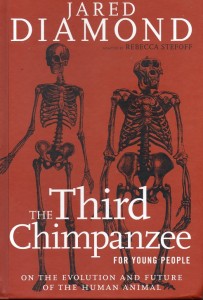Book Review: The Third Chimpanzee for Young People by Jared Diamond, adapted by Rebecca Stefoff
Disclosure: I received this book as a Goodreads giveaway on the premise that I would review it.
This is a young adult version of Jared Diamond’s The Third Chimpanzee, originally printed in 1992. I have not read that book, so will not be making direct comparisons. I have, however, read Guns, Germs & Steel, which has some overlap with this volume.
Mr. Diamond is a biogeographer and evolutionary biologist. In this book, he discusses the information (current as of 1992) that scientists have about the evolution of humans, who share about 98% of their DNA with chimpanzees. This segues into an examination of human behavior, how it is (and is not) unique among the world’s animals; and winds up with some thoughts about what this might mean for humanity’s future.
The language is clear and should be suitable for strong readers from 10-11 up; there’s also a helpful glossary at the back along with an index. There is no bibliography, presumably because the sources would not be written for young adults. There are several illustrations and sidebars to break up the text.
Parents of sensitive tweens should be aware that the book covers some “heavy” subjects, such as war and genocide. There’s also some discussion of the probable evolution of human sexuality.
A couple of chapters recap the information from Guns, Germs & Steel about why some human societies developed technology more quickly than others. Mr. Diamond frequently uses “narrative causality”; trying to find the most logical sequence of cause and effect without being able to fill in all the links in the chain.
The final chapters deal with the looming specter of environmental destruction and mass extinction of animal species. (But not anthropogenic climate change.) Mr. Diamond is pessimistic about the chances of alien contact. He does believe, however that conservation and population control can mitigate the worst effects of human behavior. After all, while evolutionary biology explains many things about human behavior, it is not the only explanation. We have free will.
This would be a good general introduction to anthropology and biogeography for middle schoolers and non-science majors. Some of the information is out of date, due to it being more than two decades since the original book was written–serious students should review the recent research as well. As Mr. Diamond repeatedly reminds us, his opinions influence his interpretation of the available evidence.


1 comment
Comments are closed.